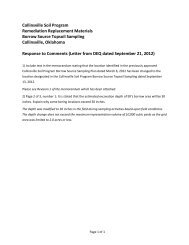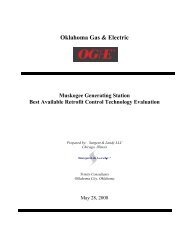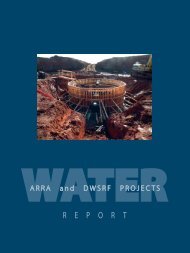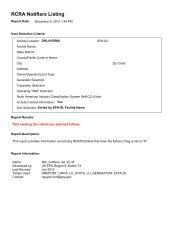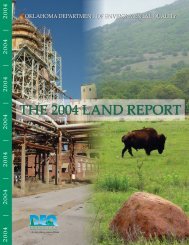Technical documentation and software quality assurance for project ...
Technical documentation and software quality assurance for project ...
Technical documentation and software quality assurance for project ...
You also want an ePaper? Increase the reach of your titles
YUMPU automatically turns print PDFs into web optimized ePapers that Google loves.
add that it is also on the order of the capacity of the largest pressurized flammable<br />
storage tanks currently manufactured. The largest I can locate after a quick<br />
internet search holds about 3,500 metric tons (located in India). The Mexico City<br />
spheres held about 1400 metric tons.<br />
It is always a difficult challenge to determine the proper input restrictions on an<br />
emergency response model. The 5000 metric ton limit is larger than any likely<br />
BLEVE scenario <strong>and</strong> there<strong>for</strong>e should not limit the responder.<br />
2. I recommend adding a note that although non-flammable pressurized liquid<br />
containers can BLEVE, the model will not calculate effects from these scenarios,<br />
since overpressure <strong>and</strong> fragmentation effects are not calculated.<br />
Note added in the technical <strong>and</strong> user <strong>documentation</strong>.<br />
3. A question on the model’s logic <strong>for</strong> calculating fireball <strong>and</strong> pool fire fractions:<br />
For scenarios where the flash fraction is less than one third of tank contents, did<br />
you mean to say that the amount not flashed is used to calculate the pool fire, or<br />
that the amount not consumed in the fireball is used in pool fire? Conserving<br />
mass would require using the amount not involved in the fireball, but using the<br />
non-flashed fraction would be a more conservative approach, which might make<br />
sense if the calculated fireball mass itself was thought to be conservative.<br />
The model displays to the user the amount of released chemical that is used to<br />
generate the fireball. The remaining chemical is assumed to <strong>for</strong>m a pool fire. This<br />
approach conserves mass but neglects possible contributions to the pool fire from<br />
rainout <strong>and</strong>, hence, is not the most conservative answer from a risk viewpoint. It is,<br />
however, consistent with existing ALOHA modeling of aerosols.<br />
The description of the BLEVE flow diagram indicates that the model uses an<br />
“average of empirical <strong>for</strong>mulas.” But it is not clear exactly what is being averaged.<br />
Maybe it is a reading comprehension problem on my part. Do you mean that it uses<br />
the average of the mass exponents <strong>for</strong> burn time <strong>and</strong> diameter? The equation at the<br />
top of page 6 indicates an exponent of 1/3. Is this exponent where the average is<br />
applied?<br />
The average (mode) applies to the mass exponent used to calculate the maximum<br />
diameter.<br />
4. Page 18 – Do I underst<strong>and</strong> correctly that if the user specifies soft ignition, but<br />
provides inputs of high reactivity <strong>and</strong> high congestion or high reactivity <strong>and</strong><br />
medium congestion (i.e., where DDT is assumed to occur), the model essentially<br />
proceeds just as if the user had specified hard ignition?<br />
37



